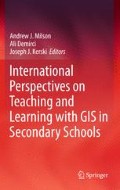Abstract
In this chapter, we focus on the status of Geographic Information System (GIS) in the secondary schools of Canada. We first discuss when and what geography is taught in the elementary through to the high school system. This is followed by a description of GIS education in the country, supported by exemplary applications of GIS in the classroom. The chapter concludes with a summary of obstacles most commonly encountered by GIS educators in schools as well as an optimistic outlook for the future.
Access this chapter
Tax calculation will be finalised at checkout
Purchases are for personal use only
References
Bahbahani, K., & Huynh, N. T. (2008). Teaching about geographical thinking. R. Case & B. Sharpe (Series Eds.).Vancouver, BC: The Critical Thinking Consortium and The Royal Canadian Geographical Society.
Bednarz, S., Bednarz, R. S., Mansfield, T. D., Semple, S., Dorn, R., & Libbee, M. (2006). Geographical education in North America (Canada and the United States of America). In J. Lidstone & M. Williams (Eds.), Geographical education in a changing world: Past experience, current trends, and future challenges (pp. 107–126). Dordrecht, The Netherlands: Springer.
Canadian Association of Geographers (CAG). (2008). Canadian Association of Geographers Geographic Education Study Group. Accessed September 12, 2010, http://info.wlu.ca/%267Ewwwgeog/CAGEDU.htm
Canadian Association of Geographers (CAG). (2009a). Canadian Association of Geographers Homepage. Accessed September 12, 2010, http://www.cag-acg.ca/en/index.html
Canadian Association of Geographers (CAG). (2009b). Geographic awareness week and geographic information systems day. Accessed September 12, 2010, http://www.cag-acg.ca/en/geography_week.html.
Canadian Council for Geographic Education (CCGE). (2001). Canadian national standards for geography: A standards-based guide to K-12 geography. Accessed September 12, 2010, http://www.ccge.org/programs/geoliteracy/geography_standards.asp
Canadian Council for Geographic Education (CCGE). (2005). Projecting geography in the Public Domain in Canada. Accessed September 12, 2010, http://www.ccge.org/programs/geoliteracy/geolit_symposium.asp
Canadian Council for Geographic Education (CCGE). (2010). Accessed September 15, 2010, http://www.ccge.org/
Crechiolo, A. (1997). Teaching secondary school geography with the use of a Geographical Information System (GIS). Unpublished master’s thesis. Wilfrid Laurier University, Waterloo, ON.
Huynh, N. T. (2009). The role of geospatial knowledge and geographic skills when reasoning in geography using Geographic Information System (GIS). Unpublished doctoral dissertation. Wilfrid Laurier University, Waterloo, ON.
Manitoba Social Science Teachers’ Association. (2010). Accessed September 15, 2010, http://www.mssta.mb.ca/
Natural Resources Canada (NRC). (2007). Atlas of Canada. Accessed September 12, 2010, http://atlas.nrcan.gc.ca/site/english/index.html
Ontario Association for Geographic and Environmental Education (OAGEE). (2010). Accessed September 15, 2010, http://www.oagee.org/
Sharpe, B., & Huynh, N. T. (2005). Geospatial knowledge areas and concepts across the Ontario Curriculum. Technical report for the GeoSkills Program, GeoConnections. Natural Resources Canada, 22 p.
Skills Canada. (2010). Skills Canada. Accessed September 12, 2010, http://www.skillscanada.com/
Statistics Canada. (2010). Statistics Canada learning resources. Accessed September 12, 2010, http://www.statcan.gc.ca/edu/index-eng.htm
Storie, C. (2000). Assessing the role of Geographical Information System (GIS) in the geography classroom. Unpublished Master’s thesis. Wilfrid Laurier University, Waterloo, ON.
Vajoczki, S. (2009). Geography education in Canada. In O. Muniz-Solari & R. G. Boehm (Eds.), Geography education: Pan American perspectives (pp. 139–155). Austin, TX: The Grosvenor Center for Geographic Education.
Warkentin, J., & Simpson-Housley, P. (2001). The development of geographical study in Canada, 1870–2000. In G. S. Dunbar (Ed.), Geography: Discipline, profession and subject since 1870 (pp. 281–316). Dordrecht, The Netherlands: Kluwer.
Author information
Authors and Affiliations
Corresponding author
Editor information
Editors and Affiliations
Rights and permissions
Copyright information
© 2012 Springer Science+Business Media B.V.
About this chapter
Cite this chapter
Huynh, N.T., Sharpe, B., Charman, C., Tong, J., Greensmith, I. (2012). Canada: Teaching Geography Through Geotechnology Across a Decentralized Curriculum Landscape. In: Milson, A., Demirci, A., Kerski, J. (eds) International Perspectives on Teaching and Learning with GIS in Secondary Schools. Springer, Dordrecht. https://doi.org/10.1007/978-94-007-2120-3_4
Download citation
DOI: https://doi.org/10.1007/978-94-007-2120-3_4
Published:
Publisher Name: Springer, Dordrecht
Print ISBN: 978-94-007-2119-7
Online ISBN: 978-94-007-2120-3
eBook Packages: Humanities, Social Sciences and LawEducation (R0)

